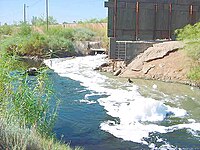
Photo from wikipedia
Abstract Objectives: US water infrastructure is in need of widespread repair due to age-related deterioration. Currently, the cured-in-place (CIPP) procedure is the most common method for water pipe repair. This… Click to show full abstract
Abstract Objectives: US water infrastructure is in need of widespread repair due to age-related deterioration. Currently, the cured-in-place (CIPP) procedure is the most common method for water pipe repair. This method involves the on-site manufacture of a new polymer composite plastic liner within the damaged pipe. The CIPP process can release materials resulting in occupational and public health concerns. To understand hazards associated with CIPP-related emission exposures, an in vitro toxicity assessment was performed. Materials and Methods: Mouse alveolar epithelial and alveolar macrophage cell lines and condensates collected at 3 worksites utilizing styrene-based resins were utilized for evaluations. All condensate samples were normalized based on the major emission component, styrene. Further, a styrene-only exposure group was used as a control to determine mixture related toxicity. Results: Cytotoxicity differences were observed between worksite samples, with the CIPP worksite 4 sample inducing the most cell death. A proteomic evaluation was performed, which demonstrated styrene-, worksite-, and cell-specific alterations. This examination of protein expression changes determined potential biomarkers of exposure including transglutaminase 2, advillin, collagen type 1, perilipin-2, and others. Pathway analysis of exposure-induced proteomic alterations identified MYC and p53 to be regulators of cellular responses. Protein changes were also related to pathways involved in cell damage, immune response, and cancer. Conclusions: Together these findings demonstrate potential risks associated with the CIPP procedure as well as variations between worksites regarding emissions and toxicity. Our evaluation identified biological pathways that require a future evaluation and also demonstrates that exposure assessment of CIPP worksites should examine multiple chemical components beyond styrene, as many cellular responses were styrene-independent.
Journal Title: Inhalation Toxicology
Year Published: 2019
Link to full text (if available)
Share on Social Media: Sign Up to like & get
recommendations!